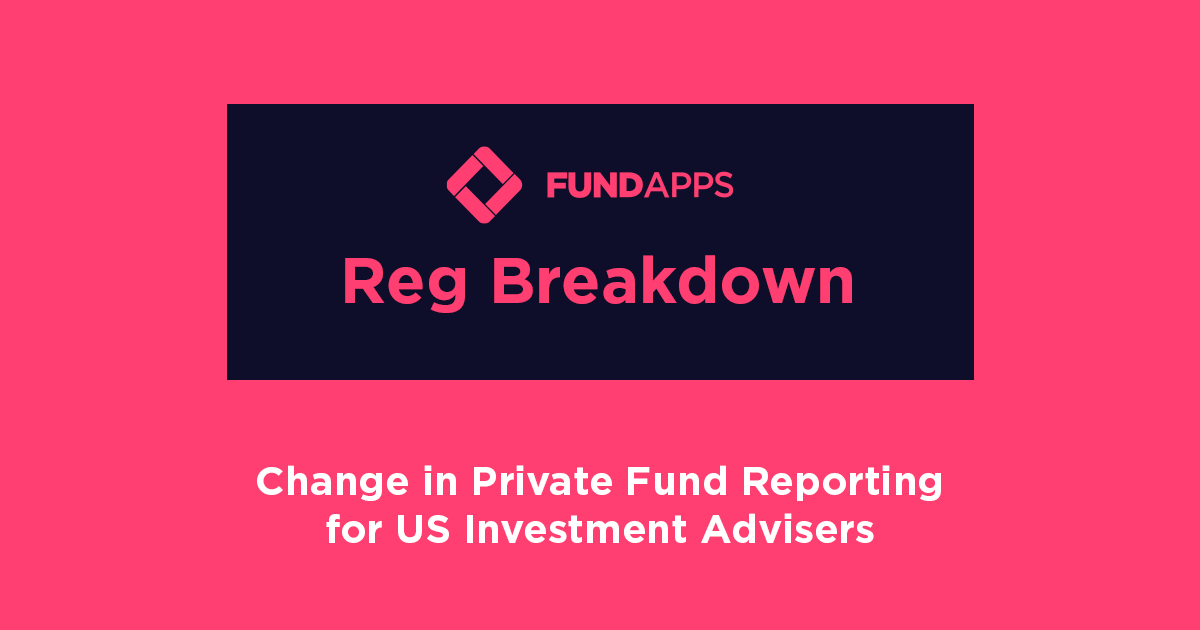In our latest blog series, we'll be taking regulatory updates that affect you directly, breaking them down and helping make sense of it all. In the previous blog, we looked into the new EU crypto reg: MiCA- The 'Mini-MiFID'.
On 10 August 2022, the SEC voted 3-2 to propose amendments to Form PF (‘the Form’). The amendments “are designed to enhance the Financial Stability Oversight Council’s (FSOC) ability to assess systemic risk as well as to bolster the SEC’s regulatory oversight of private fund advisers and its investor protection efforts in light of the growth of the private fund industry.”
Comments may be submitted until 11 October 2022. These changes along with other changes proposed in January 2022, are likely to come into effect in April 2023.
Contents
- Background
- Why Change Form PF?
- One Day Reporting for Key Events
- Master-feeders and Parallel Structures/Accounts
- General Abolition of “Look-Throughs” for Private Funds that Invest in Other Funds (Fund-of-funds)
- Trading Vehicles
- Withdrawal and Redemption Rights
- Gross Asset Value and Net Asset Value
- Inflows and Outflows
- Base Currency
- Beneficial Ownership
- What is going to happen to all the new info?
- Detractors
- Conclusion
1. Background
The Form was born in 2011 when The SEC adopted Rule 204(b)-1 under the U.S. Investment Advisers Act of 1940 (the Advisers Act).
It’s a non-public filing made by all Registered Investment Advisers (RIAs) that manage one or more private funds and that have over US $150 million in private fund assets under management. This includes RIAs that are registered with the CFTC as a commodities pool operator (CPO) or commodity trading advisor (CTA). The term “private fund” includes funds commonly known as hedge funds and private equity funds.
The information focusses on insight into a fund’s: concentration, leverage and exposures to specific assets and counterparties. The original purpose of the reporting requirement was to facilitate the collection of systemic risk data.
How often it’s filed now:
- Smaller private fund advisers are required to complete only Section 1 annually.
- Large private equity advisers, defined as those with at least US $2 billion in private equity fund assets under management, are required to complete additional details in Section 4 on an annual basis (within 120 calendar days after the year ends). This would change to $1.5 billion.
- Large hedge fund advisers, defined as those with at least US $1.5 billion in hedge fund assets under management, are required to complete Section 2 on a quarterly basis (within 60 calendar days of the end of the quarter).
2. Why change Form PF?
Growing size and complexity of the market: the SEC noted that since the Form was adopted, the private fund industry has grown, and evolved in terms of business practices, complexity of fund structures, and investment strategies and exposures.
The value of private fund net assets reported on the Form has more than doubled, growing from $5 trillion in 2013 to $12 trillion in 2021, while the number of private funds reported on the Form has increased by nearly 55 percent. Additionally, certain investment strategies, including credit, digital asset, litigation finance, and real estate strategies, have become more common.
The private funds industry is set to outgrow the commercial banking sector, but private funds are subject to less transparency. The SEC argues that greater transparency regarding the size and type of assets held by private funds would better enable FSOC to assess systemic risk in the broader US financial system.
Crypto: the proposals would create a new subclass to report on digital assets.
Crypto assets represent a stability risk because of recent growth and volatility in crypto markets.
There has been increasing allocation to crypto assets for exiting hedge funds and there are new hedge funds who only invest in crypto.
Regulators have been moving in on crypto, with the largest scheme of crypto regulation proposed by the EU: ‘MiCA’ (Markets in Crypto-Assets). Some recent developments which regulators have pointed to, amongst other things, are the collapse of:
- The stable coin, Luna;
- The price of Bitcoin; and
- Three Arrows, a crypto-focussed hedge fund.
Other concerns include crypto’s efficacy for money-laundering, terrorism-financing, and emitting carbon.
Covid-19 turmoil “highlighted the importance of receiving current and robust information from market participants”, counterparty risk is a continuing theme for regulators monitoring systemic risk, one cannot help but think of the recent collapse of Archegos and the subsequent effect on its partners.
Now, let’s turn to the proposals.
3. One Day Reporting for Key Events
These are some of the most controversial proposals.
For hedge funds, one business day would be given after the reporting event (down from 60 days after quarter-ends and 120 days for year-ends) to report on an event pertaining to:
- Extraordinary investment losses;
- Significant margin and counterparty default events;
- Material changes in prime broker relationships;
- Changes in unencumbered cash;
- Operations events; and
- Withdrawal and redemption events.
Now, most funds should be preparing these in advance of the event, but some things cannot be foreseen.
For private equity funds, the reporting requirement will relate to:
- The execution of adviser-led secondary transactions;
- Implementation of general partner or limited partner clawbacks;
- Removal of a funds general partner;
- Termination of a funds investment period;
- Termination of a fund.
4. Master-Feeders and Parallel Structures/Accounts
A “master-feeder arrangement” is an arrangement in which one or more funds (“feeder funds”) invest all or substantially all their assets in a single private fund (“master fund”).
A “parallel fund structure” is a structure in which one or more private funds (each, a “parallel fund”) pursues substantially the same investment objective and strategy and invests side by side in substantially the same positions as another private fund.
The SEC said that experience with the Form data has identified potential ways to improve data quality, including in instances where existing reporting may not fully identify the potential risks, such as in the reporting of certain master-feeder arrangements.
The SEC said they are proposing amendments that would require advisers to separately report each component fund of a master-feeder arrangement and parallel fund structure. However, an adviser would continue to aggregate these structures for purposes of determining whether the adviser meets a reporting threshold. In essence, there would still need to report the same money but at a more granular level of each component fund.
Previously funds had more flexibility, but the SEC said it is resulting in ‘obscured risk profiles’ (e.g., asset size, counterparty exposure, investor liquidity) and made it difficult to compare complex structures, undermining the utility of the data collected.
Additional reporting would also be required for ‘parallel managed accounts’. A “parallel managed account” is any managed account or other pool of assets managed by the adviser that pursues substantially the same investment objective and strategy and invests side by side in substantially the same positions as the private fund.
5. General Abolition of “Look-Throughs” for Private Funds that Invest in Other Funds (Fund-of-funds)
The SEC has proposed to amend the Form instructions to require an adviser to include the value of a reporting fund’s investments in other private funds when responding to questions on the Form.
Currently, advisers are not required to, but nonetheless have the option to, “look through” a reporting fund’s investments in any other entity (including other private funds), except in instances when the form directs otherwise. As a result, some advisers may “look through” a reporting fund’s investments in other entities, while others do not, leading to unclear data, inconsistent comparisons, and less precise analysis across advisers.
The SEC therefore proposed to amend the instructions to provide that, when responding to questions, advisers must not “look through” a reporting fund’s investments in internal private funds or external private funds (other than a trading vehicle) unless the question instructs the adviser to report exposure obtained indirectly through positions in such funds or other entities.
6. Trading Vehicles
Private funds use trading vehicles for various purposes, including:
- For jurisdictional, tax, or other regulatory purposes; or
- To “ring-fence” assets in light of liability or bankruptcy concerns associated with a particular investment.
If the reporting fund uses a trading vehicle, and the reporting fund is its only equity owner, the adviser would either:
- Identify the trading vehicle, and report answers on an aggregated basis for the reporting fund and such trading vehicle; or
- Report the trading vehicle as a separate reporting fund.
If reporting separately:
- Advisers would report the trading vehicle as a hedge fund if a hedge fund invests through the trading vehicle;
- Advisers would report the trading vehicle as a qualifying hedge fund if a qualifying hedge fund invests through the trading vehicle;
- Otherwise, advisers would report the trading vehicle as a liquidity fund, private equity fund, or other type of fund based on its activities.
Currently, the Form does not require advisers to identify trading vehicles. As a result, the Form does not provide a clear window into the use of trading vehicles and the risks they present. E.g., if a trading vehicle is ring-fenced, the current Form does not provide a view into the assets or collateral on which a counterparty to such trading vehicle relies, or the size and nature of the trading vehicle’s exposure.
In addition, where more than one reporting fund invests through a particular trading vehicle, the activities of multiple reporting funds are blended and potentially obscured.
7. Withdrawal and Redemption Rights
The current form only requires large hedge fund advisers to report whether each qualifying hedge fund provides investors with withdrawal or redemption rights in “the ordinary course.”
The proposal would make this mandatory for all fund advisors who would need to provide this information for each reporting fund.
The SEC said the purpose of the proposal is to inform the SEC, the CFTC and FSOC better of all reporting funds’ susceptibility to stress through investor redemptions, to help identify how widespread the stress is.
8. Gross Asset Value and Net Asset Value
Funds who are providing quarterly figures would need to explain this on a month-by-month basis rather than just the quarter. The SEC said that this proposed amendment is designed to facilitate analysis of other monthly Form data, including certain fund performance and risk metrics.
Unfunded commitments: advisers would need to separately report these now. The SEC said that knowing the value of uncalled commitments would help the Commissions and FSOC more accurately identify how much leverage a fund with uncalled commitments has. Currently, they can only infer this information, it is unclear whether such inferences are correct.
9. Inflows and Outflows
The proposed amendments would require advisers to report information concerning the reporting fund’s activity, including contributions to the reporting fund, as well as withdrawals and redemptions, which would include all withdrawals, redemptions, or other distributions of any kind to investors.
The SEC said that the purpose of the amendments is to provide a more accurate baseline understanding of inflows and outflows, so they can, for example, more accurately assess how much the private fund industry has grown from flows versus performance.
Inflows and outflows also can indicate funding fragility, which can have systemic risk implications. The amendment is designed to provide more accurate data of inflows and outflows for systemic risk assessment and investor protection efforts, including identifying activity that may not match investor disclosure.
10. Base Currency
The proposal would impose a requirement for all advisers to identify the base currency of all reporting funds, not just large hedge funds. This would also pertain to cash equivalents like digital assets, which would be reported separately.
These proposals would enhance monitoring of currency risk and also crypto-markets as discussed above.
11. Beneficial Ownership
Enhanced requirements for beneficial ownership are proposed, including as to what type of institution is the beneficial owner and whether they are a US or non-US person.
The SEC said this is to conduct more targeted analysis about risks presented in the United States separate from risks presented abroad.
Owners that are private funds would need to say whether they are internal private funds or external private funds. This is for the SEC to understand a reporting fund’s risk from investor demands for liquidity, because beneficial owners that are external private funds may have less predictable withdrawals than internal private funds.
12. What is going to happen to all the new info?
What will the SEC, the CFTC and FSOC do with all this new information?
Enforcement and Examinations: we expect Form data to be shared with the SEC’s divisions of Enforcement and Examinations, indeed the SEC acknowledges the use of Form data in examinations and enforcement investigations in the proposal.
Deploying Regulatory Tools: we expect that FSOC would use the new information collected on the Form, together with market data from other sources, to assist in determining whether and how to deploy its regulatory tools. So, digging into funds that present a risk and changing the law for risky activities that they can see in the data.
13. Detractors
The SEC Commissioners voted for the proposals 3-2.
SEC Commissioner Mark Uyeda slammed the proposals: “today’s proposed amendments to Form PF, which come on the heels of an existing proposal to amend Form PF issued earlier this year — would impose additional and more granular disclosures, with effects that could potentially reshape an industry that is already dominated by large fund advisers.”
Additionally Uyeda criticised the fact that, despite it being a private form, workers at the SEC, CFTC and FSOC cannot unsee the information they gather, so enhanced collection of sensitive information would likely be deleterious to the privacy and competitive advantage of advisers and their clients.
The other Commissioner who voted against the proposals was Hester Pierce, who said the FSOC “does not need to have this kind of detailed knowledge of individual private funds’ activities.”
14. Conclusion
Information Use
We expect that the information provided on the amended Form PF would be used more often in conjunction with the SEC’s enforcement program, rather than FSOC’s monitoring of systemic risks.
In any event, if advisers are providing more and more information, we should expect it to be used properly and not lay unused in regulators’ databases. As the famous polymath Herbert Simon once said: “a wealth of information creates a poverty of attention.”
Resources
The Form is already very resource intensive for fund advisers. The substantive changes in the proposal would represent significant departures from prior practice which would further increase this burden.
We encourage affected firms to consider responses sooner rather than later to the proposals.
To find out more on how you can work with FundApps to automate Form PF filings, feel free to get in touch anytime.



